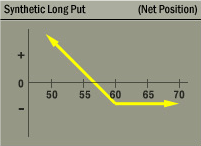Synthetic Long Put
This strategy combines a long call and a short stock position.
Description
By combining a long call option and a short stock position, the investor simulates a long put position. The object is to see the combined position gain value as the result of a predicted decline in the underlying stock's price.
It is not particularly popular, because it entails a short stock position. A synthetic long put is often established as an adjustment to what was originally simply a short stock position.
There is one possible advantage over a long put: in the event of an extended trading halt, the synthetic long put strategy does not require any action since the stock was sold when the strategy was implemented. However, as with any short sale, there is always a risk of being forced to return the stock.
Outlook
Looking for a sharp decline in the stock's value during the life of the option.

EXAMPLE
- Short 100 shares XYZ stock
- Long 1 XYZ 60 call
MAXIMUM GAIN
- Short sale price - premium paid
MAXIMUM LOSS
- Strike price - short sale price premium paid
Summary
This strategy combines a long call and a short stock position. Its payoff profile is equivalent to a long put's characteristics. The strategy profits if the stock price moves lower. The faster and sharper the move lower, the better. The time horizon is limited to the life of the option.
Motivation
The only motive is to profit from a fall in stock's price.
Variations
N/A
Max Loss
The maximum loss is limited. The worst that can happen is for the stock price to be above the strike price at expiration, in which case the short stock position can be closed out by exercising the call option. The loss would be the selling price of the stock (where it was sold short), less the purchase price of the stock (the strike price), less the premium paid for the call option.
Max Gain
The maximum gain is limited but potentially substantial. The best that can happen is for the stock to become worthless. In that case, the investor could buy the stock for zero to close out the short stock position. The total profit, however, would be reduced by the premium paid for the call option, which expired worthless.
Profit/Loss
This strategy has the same payoff profile as a long put: limited losses if the stock rises, and substantial though limited gains if the stock declines. The timeline is limited, too, with one exception. Assuming the investor isn't asked to return the stock, and if the call expires worthless, the investor will still have a short stock position.
Breakeven
At expiration, the strategy breaks even if the stock price has declined by an amount equal to the premium paid for the option.
Breakeven = initial short sale price - premium paid
Volatility
An increase in volatility would have a positive impact on this strategy, all other things equal. For one thing, it would tend to boost the long call option's resale value.
Time Decay
The passage of time will have a negative impact on this strategy, all other things being equal. As expiration approaches, the call's resale value tends to converge on its intrinsic value, which for out-of-the-money options is zero. Also, the sooner the call expires, the sooner it ceases to offer protection for the short stock position in the event of an unexpected rally.
Assignment Risk
None. The investor is in control.
Expiration Risk
There should be none. Presumably, if this position is held into expiration and the option is sufficiently in-the-money to be exercised, the investor will want to exercise the option to close out the short stock position.
Comments
N/A
Related Position
Comparable Position: Long Put
Opposite Position: Covered Call

